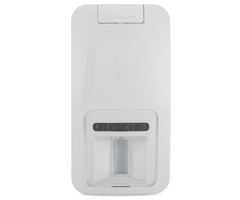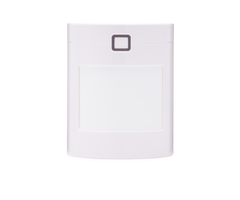What Is a Pet Immune Motion Sensor?
A pet-immune motion sensor is a motion detecting sensor that is designed to detect humans walking upright, while ignoring small animals that are walking close to the ground. Mounting height and positioning is extremely important for a pet immune motion detecting sensor to work correctly.

The purpose of a pet immune motion sensor is to allow small animals or pets to move around a building freely without causing a false alarm. At the same time, the motion sensor will still detect humans moving throughout the same area. In other words, the motion sensor will still alert the system to an intruder who breaks into the building. You are basically getting the best of both worlds. Your dog or cat can move around and play while you are gone, but your system will still go into an alarm if someone breaks-in and walks past your motion sensor.
At Alarm Grid, we like to think of these motion detectors as "Pet Friendly" instead of "Pet Immune". There really is no such thing as a "Pet Immune" motion detector. If any size pet, or even if a moving inanimate object such as a balloon, or holiday decorations can come within six (6) feet of the front of the motion detector while the system is armed, an alarm will occur. Pet friendly motion detectors work by allowing you to decrease their sensitivity, instructing that they be mounted at least seven (7) feet up from the floor, and by masking the portion of the lens that looks downward at the floor.
A motion sensor isn't smart enough to determine whether detected movement is caused by your pet or by a dangerous criminal. To solve this issue, some pet immune motion sensors will have two (2) separate detection patterns. There will be a lower pattern that will look close to the ground where a small animal would move. There will also be an upper pattern that looks where a human would be walking upright. These pet-immune motion sensors will only activate if both detection patterns are triggered. An example of a motion sensor that uses this method is the 5800PIR-OD.
This can be seen in the following picture:

Most pet immune motion sensors will offer pet immunity for small animals up to a certain weight. If a pet immune motion sensor says that it provides pet immunity of "up to 40 pounds", then that means a small animal weighing more than 40 pounds will probably activate the sensor. But remember that these listed weights are just estimates. The real consideration is whether or not the small animal will get within the sensor's field of view.
It is important to understand that pet-immune motion sensors are not perfect. If a pet manages to get up in the upper detection area, it will still trigger the motion sensor. For example, if you have your motion sensor facing a couch, and your pet climbs on top of the couch, they might still activate the sensor. You must choose the location of your pet immune motion sensor very carefully. You should also mount it at a proper height. Mounting it too low may allow your pet to get within its detection area. The standard mounting height for a pet immune motion detector is between 7.5 feet and 8 feet high. Finally, you should use the lowest detection sensitivity possible for a pet immune motion sensor.
Did you find this answer useful?
We offer alarm monitoring as low as $10 / month
Click Here to Learn MoreRelated Products
























Related Videos
Related Categories
- Answered





